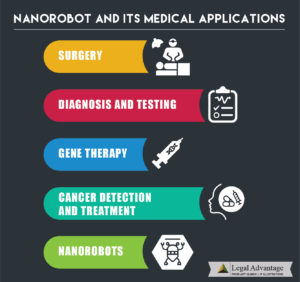Nanorobot and its medical applications
NanoRobotics is the technology of creating machines or robots close to the microscopic scale of a nanometer (10-9 meters). Nanorobots remain a theoretical concept as no artificial, non-biological nanorobots have yet been created.
Nanorobots can be used in a wide range of applications. Nanorobots have several components such as sensors, actuators, control, power communication. Potential uses for nanorobotics in medicine include early diagnosis and targeted drug delivery for cancer, biomedical instrumentation, surgery, pharmacokinetics, monitoring of diabetes, and other health care related issues that need utmost support to save human lives.
Nanorobots Applications
- Surgery
Surgical nanorobots can be introduced into the human body through vascular systems and other cavities. Surgical nanorobots act as semi-autonomous on-site surgeon inside the human body and are programmed or directed by a human surgeon.
- Diagnosis and Testing
Medical nanorobots can be used for the purpose of diagnosis, testing, and monitoring of microorganisms, tissues and cells in the bloodstream. These nanorobots can detect pathogens or toxins inside the body and can maintain the record, and report some vital signs such as temperature, pressure and immune system’s parameters of different parts of the human body continuously.
- Gene Therapy
Nanorobots are also applicable in treating genetic diseases, by relating the molecular structures of DNA and proteins in the cell. The modifications and irregularities in the DNA and protein sequences are then corrected (edited).
- Cancer Detection and Treatment
The current stages of medical technologies and therapy tools are used for the successful treatment of cancer. The important aspect to achieve a successful treatment is based on the improvement of efficient drug delivery to decrease the side-effects from chemotherapy. Nanorobots with embedded chemical biosensors are used for detecting the tumor cells in early stages of cancer development inside a patient’s body.
- Nanorobots can also be used as ancillary devices for processing different chemical reactions in the affected organs. These robots are also useful for monitoring and controlling glucose levels in diabetic patients.
Intellectual Property
The first patent published related to nanorobot was in 1999. A large number of patents have been granted recently on nanorobots with the US leading with more 90% of the total patents.
Source:
https://www.elprocus.com/nanorobots-and-its-application-in-medicine/
